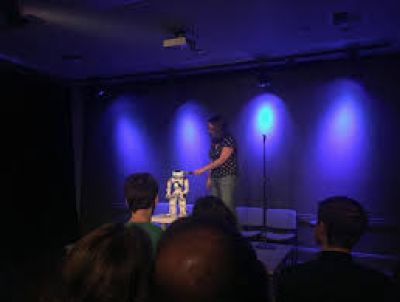Don’t you hate it,” says Jon the Robot, gesturing with tiny articulated arms at an expectant crowd, “when you’re trying to solve inverse kinematics equations to pick up a cup and then you get ‘Error 453, no solution found’?” The crowd laughs. “Don’t you hate that?”
An experiment billed as a comedy act, Jon is the brainchild of Naomi Fitter, an assistant professor in the School of Mechanical, Industrial and Manufacturing Engineering at Oregon State University. The tiny android performs when a handler (who must also hold the mic) presses a button, then tells the same jokes in the same order, like a grizzled veteran comic at a down-market Vegas casino.
But the robot’s act is more human than it might first appear. Jon is learning how to respond to its audience—it can now vary the timing of its delivery based on the length of the audience’s laughter, and append different responses to jokes based on the level of noise in the room. It can deliver one line if a joke gets a roar of laughter (“Please tell the booking agents how funny that joke was”) and another if there are crickets (“Sorry about that. I think I got caught in a loop. Please tell the booking agents that you like me … that you like me … that you like me”).
The prospect of an AI that understands why we are laughing, and that can generate its own genuinely funny material, is sort of a holy grail for a subset of AI researchers. Artificial intelligence can diagnose tumors, read maps and play games, often faster and with more accuracy than humans can.
For the moment, however, linguistic humor is still primarily a people thing. Jon can work blue, with a whole bit on robot dating that involves cryptic texts, encrypted text, and the eggplant emoji—but only because a human has written and programmed a set list for it. Finding a way to teach machines to be funny on their own would be a major breakthrough—one that could fundamentally reshape the way we relate to the devices around us. To understand a person’s humor is to know what they like, how they think and how they see the world. An AI that understands all that has the power to do a lot more than just crack jokes.
The first step is to attempt to break down the nuts and bolts of human humor. Machines learn by taking vast amounts of data and feeding it through algorithms—in other words, formulas or detailed sets of instructions—in search of patterns or unique features. This process works when it comes to, say, identifying the difference between photos of dogs and photos of cars, but it can effectively destroy a joke, deconstructing it in a painfully unfunny operation. “Explanations are to jokes what autopsies are to bodies: if the subject isn’t already dead, it soon will be,” wrote University College Dublin associate professor Tony Veale in his recent book Your Wit Is My Command: Building AIs With a Sense of Humor.
Humans have vast mental libraries of cultural references and linguistic nuances to draw upon when hearing or telling a joke. AI has access only to the information that humans choose to give it, which means that if we want an AI to make us laugh, we have to be clear about the kind of humor we want to teach it.
Time

